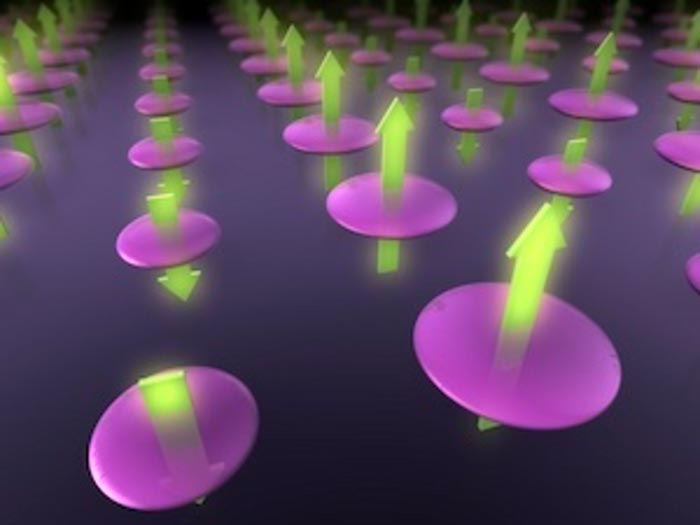Nanodisks should not be taken lightly

First BIC state from magnetic (green arrows) dipoles
Credit: KyotoU/Shunsuke Murai
Application of Non-Bravais lattices to light control technology.
A novel light-manipulating technology has been developed by an international team, including Kyoto University, that can be applied to lasers, sensors, and nonlinear optics.
The technique tightly confines near-infrared light within a nanodisk periodic structure. By breaking the symmetry of the periodic square lattice of silicon nanodisks, the team has demonstrated experimentally and computationally their ability to systematically control bound states in the continuum, or BICs.
These light distribution states result from global cancellation of light escaping by destructive interference of scattering waves from silicon nanodisks.
“In this study, starting from a periodic square lattice of a silicon nanodisk — a Bravais lattice — three types of non-Bravais lattices were made by varying the position of a second lattice point in the unit lattice and the size of the disc,” explains lead author Shunsuke Murai.
In Bravais lattices, used in crystallography to help us understand and classify crystal structures, all the lattice points were equivalent, meaning all those points could be superimposed by the unit cell.
Non-Bravais lattices were created by introducing a second non-equivalent lattice point. These samples were produced using electron-beam lithography and dry etching.
“We applied phototonic, or photosensitive, non-Bravais lattices consisting of silicon nanodisks to control near-infrared light,” the author adds.
However, by selecting the appropriate period of these lattices and the material of the nanodisks, not limited to silicon, BIC control may be possible over a wide frequency range from UV to millimeter waves.
Murai concludes, “The robustness of BIC control over the imperfections in fabricating these lattices was a bonus and an encouraging surprise, given that manufacturing flaws are inevitable.”
The paper “Engineering bound states in the continuum at telecom wavelengths with non-Bravais lattices” appeared on 26 August 2022 in Laser & Photonics Reviews, with doi: 10.1002/lpor.202100661
About Kyoto University
Kyoto University is one of Japan and Asia’s premier research institutions, founded in 1897 and responsible for producing numerous Nobel laureates and winners of other prestigious international prizes. A broad curriculum across the arts and sciences at both undergraduate and graduate levels is complemented by numerous research centers, as well as facilities and offices around Japan and the world. For more information please see: http://www.kyoto-u.ac.jp/en
Journal: Laser & Photonics Review
DOI: 10.1002/lpor.202100661
Method of Research: Experimental study
Subject of Research: Not applicable
Article Title: Engineering bound states in the continuum at telecom wavelengths with non-Bravais lattices
Article Publication Date: 26-Aug-2022
COI Statement: The authors declare no conflict of interest.
Media Contact
Jake G. Tobiyama
Kyoto University
tobiyama.gakuji.6y@kyoto-u.ac.jp
All latest news from the category: Physics and Astronomy
This area deals with the fundamental laws and building blocks of nature and how they interact, the properties and the behavior of matter, and research into space and time and their structures.
innovations-report provides in-depth reports and articles on subjects such as astrophysics, laser technologies, nuclear, quantum, particle and solid-state physics, nanotechnologies, planetary research and findings (Mars, Venus) and developments related to the Hubble Telescope.
Newest articles

Superradiant atoms could push the boundaries of how precisely time can be measured
Superradiant atoms can help us measure time more precisely than ever. In a new study, researchers from the University of Copenhagen present a new method for measuring the time interval,…

Ion thermoelectric conversion devices for near room temperature
The electrode sheet of the thermoelectric device consists of ionic hydrogel, which is sandwiched between the electrodes to form, and the Prussian blue on the electrode undergoes a redox reaction…

Zap Energy achieves 37-million-degree temperatures in a compact device
New publication reports record electron temperatures for a small-scale, sheared-flow-stabilized Z-pinch fusion device. In the nine decades since humans first produced fusion reactions, only a few fusion technologies have demonstrated…





















